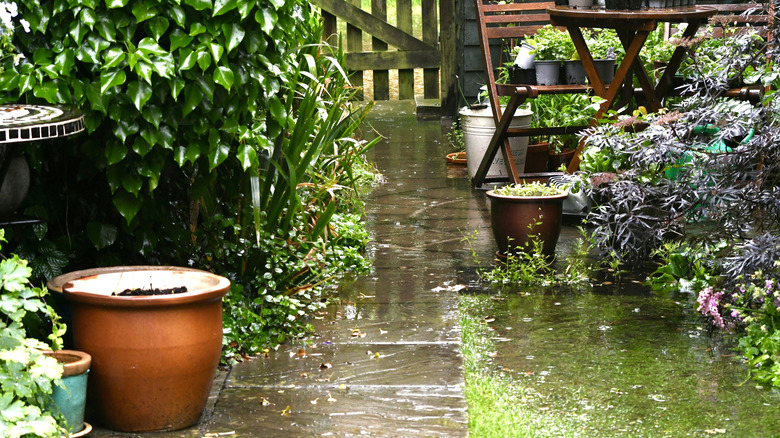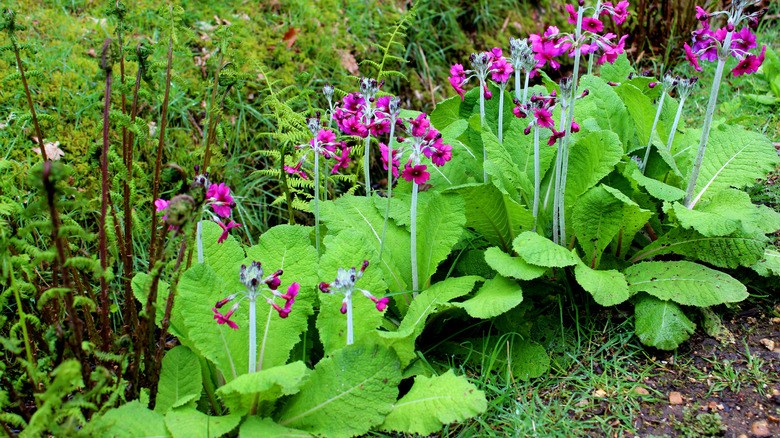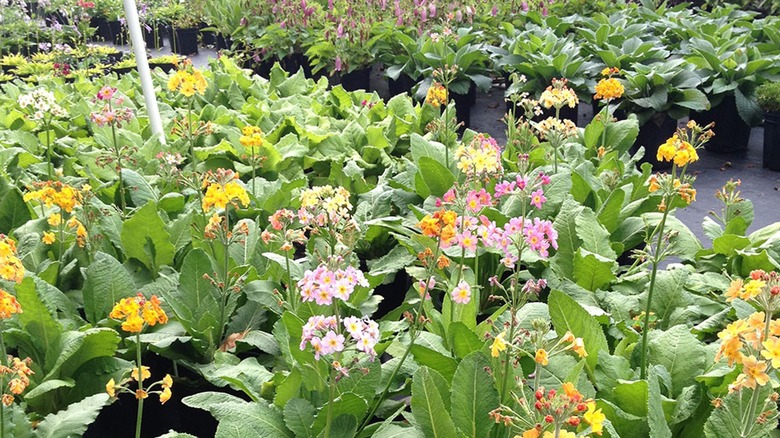The Bold Ground Cover That Spreads Beautifully In Soggy Soil
We may receive a commission on purchases made from links.
Damp, shady spots in the garden can be challenging to get right, even for experienced gardeners. There just aren't that many plants willing to put down roots and thrive in such conditions. What really happens to your garden during periods of excessive rain or even just in a regularly soggy area is that most species of flora perish in the waterlogged soil, while a select few flourish. Candelabra primulas are among such plants, relishing moist shade and pretty much any soil (those tricky clay soils included) along pond, stream, and garden bed borders. What's more, they're hearty spreaders; a single Primula japonica plant, a common candelabra primula species, will take up over a foot round of the garden bed.
There are quite literally hundreds of Primula, also known commonly as primrose, species — over 400 to date — and the huge and varied genus has been further divided into an orderly 37 sections by the horticultural community. Candelabra primula (or primrose) species, hybrids, and cultivars sit within the section Proliferae. Primulas are native to eastern and south-eastern Asia: Nepal, Tibet, and China through Japan and Taiwan, and down to Myanmar and Indonesia. There, they thrive in marshlands and woodlands, in fields and on alpine slopes. Candelabra primulas typically flower May through June, sending up the distinctive tiered clusters of blooms in all colors of the rainbow on the tall, thick stems that give them their moniker. Any shade gardener worth their secateurs will plant this primrose species as a late May blooming highlight.
Why candelabra primulas thrive in damp soil
If you're looking for flowering plants that thrive in soggy soil, few species match the mettle of candelabra primulas. These hardy plants thrive in damp soils, so much so that they will wilt and die in a dry garden. Though they are generally quite hardy, their toughness doesn't extend to drought. Candelabra primulas like Primula japonica and its cultivars prefer organic-rich soil, but — and here's that moisture-loving trait coming into play again — they grow in well-draining loamy, sandy, or clay-based soils so long as you keep the environment perpetually damp. Add some gravel or sand to the soil and choose a sloping garden bed to improve drainage and reduce the likelihood of root rot. This is especially important in the winter, when candelabra primulas retreat into a protective subterranean bud that's vulnerable to rotting.
Perhaps the most attractive feature of candelabra primroses for gardeners with difficult sites is that most species do as well in full sun as they do in partial shade. They may lose leaves if the temperature rises too high; planting them in a shady spot rather than full sun can mitigate this. They won't, however, survive deep, dry shade. With this in mind, the best settings for candelabra primrose include the edges of small human-made ponds (though watch the soil depth over the pond liner — shallow edges can dry out) and natural bogs and creeks. Their tall-stemmed blooms make them standouts in whimsical cottage gardens, against a background of sturdy evergreen shrubs, or as a border plant along woodlands, lawns, or walkways.
Where to find and how to grow candelabra primulas
The best known and most colorful species of candelabra primulas is Primula japonica and its cultivars. For example, 'Miller's Crimson' has vibrant red-purple blooms, while 'Postford White' has, as the name suggests, ivory flowers. Primula beesiana and Primula bulleyana are the other species most often seen at nurseries. Primula veris (cowslip) has sunshine yellow flowers, and Primula × bulleesiana has pretty pink blooms. The white flowering Primula alpicola var. Alba is long-lived in USDA Hardiness Zones 4 through 8, Primula chungensis has some of the most delicate flowers of the bunch in an unusual apricot hue, and Primula cockburniana is one of the smallest candelabra species. Live candelabra primula plants can be found at local nurseries in the spring. If you're not too fussed about which species you get, purchase a packet of 100 Generic Candelabra Primula Seeds for about $15.
Learning how to grow and care for primrose plants is relatively simple. Sow primrose seeds in the cooler months and keep the soil damp at all times for best success. In cold areas, transplant seedlings into the garden after the last hard frost, planting each seedling about 4 to 6 inches apart. Only buy a few plants. Candelabra primulas self-seed readily — sometimes to the point of takeover in ideal growing conditions — and they will eventually cover a large area without you having to purchase more, unless you want a particular mix of bloom colors. They cross-pollinate enthusiastically, meaning the flowers of new plants may not be the same as their parent.


